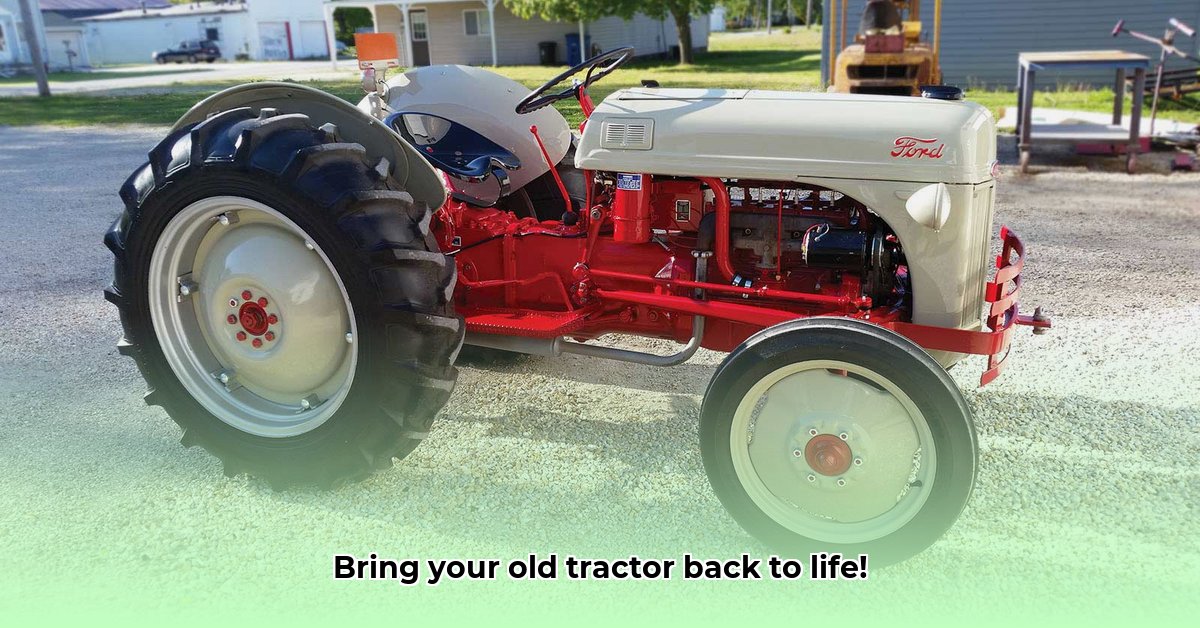
A Blast from the Past: The Significance of Old Tractor Restoration
Restoring an old tractor is more than a mechanical project; it's a celebration of agricultural history. These machines, once the backbone of farming, represent ingenuity and hard work. Their preservation connects us to our past and honors the legacy of those who shaped our food systems. Restoring them isn't merely fixing metal; it's a tribute to a bygone era. Isn't it rewarding to give these dependable machines a second life? For example, see this 1970 Ford 4000 restoration project.
The Restoration Journey: A Step-by-Step Guide
The restoration process unfolds in distinct stages, each requiring patience, skill, and perseverance. Let's break down this complex puzzle:
Dismantling: Methodically disassemble the tractor, meticulously documenting each part's location with photos. This detailed blueprint is essential for reassembly.
Parts Sourcing: This is often the most challenging phase. Original parts are ideal, but reproductions and even repurposed parts offer viable alternatives. Online forums and specialized suppliers are invaluable resources.
Repair and Fabrication: This involves fixing, replacing, or fabricating parts. Welding skills are beneficial, and professional help may be necessary. Thorough repairs ensure mechanical soundness.
Painting: Paint selection is crucial, not only for aesthetics but also historical accuracy. High-quality, weather-resistant paint is essential.
Reassembly: Using your detailed documentation, carefully reassemble the tractor, ensuring perfect alignment and functionality. Precision and patience are critical elements.
Testing: Before declaring victory, thoroughly test the restored tractor to ensure all systems operate correctly. A methodical approach safeguards against potential problems.
The Economics of Restoration: Cost, Market, and Viability
Restoring an old tractor is a significant financial undertaking. Costs vary significantly based on the tractor's condition, the extent of repairs, and parts availability. While a market exists for restored tractors, its dynamics are complex. Profitability hinges on expertise, efficiency, and skillful parts sourcing. How can you accurately budget for such a multifaceted project?
Sustainable Restoration: Minimizing the Environmental Impact
Sustainable practices are becoming increasingly important in tractor restoration. Sourcing recycled or reclaimed parts, minimizing waste, and using eco-friendly paints reduce your project's environmental footprint. This aligns with the growing focus on sustainable agriculture and demonstrates environmental responsibility. Isn't it satisfying to minimize your impact on the planet?
Finding the Right Restorer: Partnering for Success
Selecting a competent restorer is key. Look for:
Proven Experience: A strong track record and experience with similar tractors are paramount.
Reputation: Thoroughly check online reviews and seek referrals. A visit to their workshop can provide valuable insights.
Insurance: Adequate insurance protects you from potential damages during the restoration process.
Sustainable Practices: If environmentally friendly restoration is important, ensure the restorer shares your values.
DIY Restoration: Mastering the Basics Safely
For mechanically inclined individuals, tackling minor restoration tasks is both rewarding and cost-effective. Safety is paramount: Always wear appropriate protective gear. Start with:
Cleaning: Remove dirt, grime, and rust.
Lubrication: Apply lubricants to prevent rust and ensure smooth operation.
Minor Repairs: Address simple repairs like tightening bolts and replacing worn components.
Sourcing Parts: Navigating the Supply Chain
Parts sourcing presents the greatest challenges. Consider:
Original Parts: Ideal but rare and expensive.
Reproduction Parts: More readily available and affordable, but quality varies.
Sustainable Alternatives: Recycled or repurposed parts offer an eco-friendly solution.
Budgeting and Planning: A Realistic Approach
Thorough planning is crucial. Develop:
A Detailed Budget: Include all costs, and allow for unexpected expenses (often significant).
A Realistic Timeline: Account for potential delays inherent in such projects.
Contingency Planning: Have a plan B for handling unforeseen setbacks.
Weighing the Pros and Cons: Is Restoration Right for You?
The decision to restore an old tractor involves careful consideration. The table below summarizes the key advantages and disadvantages. Will the rewards outweigh the challenges in your specific situation?
| Pros | Cons |
|---|---|
| Preserving history | Significant financial investment |
| Gaining valuable skills | Time-consuming and labor-intensive |
| Owning a unique machine | Requires specialized tools and knowledge |
| Potential appreciation in value | Parts sourcing difficulties |
| Environmentally friendly (with care) | Potential delays and unforeseen complications |
Remember, restoring an old tractor is a marathon, not a sprint. Enjoy the journey!